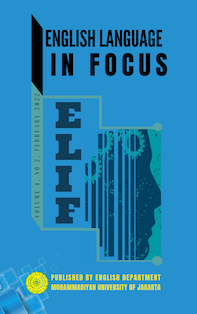Using Infographic Through Reporting Technique to Improve Speaking Skill
DOI:
https://doi.org/10.24853/elif.4.2.171-178Keywords:
Info graphic, reporting technique, and speaking skillAbstract
Nowadays, the using of learning media helps in developing learners' learning abilities. In the current digital information era, the use of digital info graphic is a learning medium to improve students' speaking skill. Info graphic is instructional learning aid that can effectively convey information quickly and easily. By combining brief information in points and graphics assist students in conveying specific topics which also develop students' speaking skill. This study used a qualitative descriptive method with case study approach. The researchers employed three instruments; observation, questionnaire, and interview. The implementation of this research involved twenty students from the English 1 subject at English Education Department UIN Maulana Malik Ibrahim Malang. The first findings revealed that the use of info graphic with reporting techniques could improve students' speaking skills, increased creativity, and ease of use for lecturer and students to transfer material. The characteristics of info graphic are comprehension, retention, and attractiveness. The second finding, students expressed a positive response of the use of info graphic aid in the online classroom. Furthermore, students are expected to apply info graphic tool to other subjects.References
Aboe, R. M. (2018). Enhancing the students speaking interest through news reporting technique. Asian EFL Journal, 20(7), 153–161.
Aldila, T. H., Musadad, A. A., & Susanto, S. (2019). Infografis sebagai Media Alternatif dalam Pembelajaran Sejarah bagi Siswa SMA. Andhapura: Jurnal Desain Komunikasi Visual & Multimedia, 5(01), 141–152. https://doi.org/10.33633/andharupa.v5i01.2104
Ary, et al. (2010). Introduction to Research in Education. Wadsworth: Cengage Learning
Babbie, E. (1990). Survey Research Methods. 2nd Edition. Wadsworth: Belmont.
Barras, Robert. (2006). Speaking for Yourself: A guide for Students. New York: Routledge Taylor and Francis Group.
Kayi, Hayriye. (2006). Teaching Speaking: Activities to Promote Speaking in a Second Language. The Internet TESL Journal, Vol. XII, No. 11, November 2006.
Lankow, J. (2015). Infografis: Kedahsyatan Bercerita Visual (pp. 11–56). PT. Gramedia.
Marzuki, A. G. (2017). Developing Speaking Skill through Oral Report in an EFL Class in Indonesia. Al-Ta Lim Journal, 24(3), 243–254. https://doi.org/10.15548/jt.v24i3.330
Miles, Mattew B.; Huberman, A. M. (1994). Qualitative Data Analysis (second edi). SAGE Publications.
Miftah, M. Nurul, Rizal, Edwin, & Anwar, R. Khairul. (2016). Pola Visual Infografer dalam Pembuatan Informasi Grafis (Infografis). Jurnal kajian Informasi & Perpustakaan. p 87.
Naparin, H., & Binti Saad, A. (2017). Infographics in Education : Review on Infographics Design. The International Journal of Multimedia & Its Applications, 9(4/5/6), 15–24. https://doi.org/10.5121/ijma.2017.9602
Ozdamli, F., Kocakoyun, S., Sahin, T., & Akdag, S. (2016). Statistical Reasoning of Impact of Infographics on Education. Procedia Computer Science, 102(August), 370–377. https://doi.org/10.1016/j.procs.2016.09.414
Panjaitan, R. (2019). Metodologi Penelitian. https://doi.org/10.31220/osf.io/uk47t
Senjaya, W. F., Karnalim, O., Handoyo, E. D., Santoso, S., Tan, R., Wijanto, M. C., & Edi, D. (2019). Peran Infografis Sebagai Penunjang dalam Proses Pembelajaran Siswa. Altruis, 2(October), 55–62. https://doi.org/10.24071/altruis.2019.020108
Zuriah,N. (2007). Metodologi Penelitian Sosial dan Pendidikan: Teori dan aplikasi. Jakarta: PT Bumi Aksara
Downloads
Published
Issue
Section
License
Authors who publish with this journal agree to the following terms:
- Authors retain copyright and grant the journal right of first publication with the work simultaneously licensed under a Creative Commons Attribution License that allows others to share the work with an acknowledgment of the work's authorship and initial publication in this journal.
- Authors can enter into separate, additional contractual arrangements for the non-exclusive distribution of the journal's published version of the work (e.g., post it to an institutional repository or publish it in a book), with an acknowledgment of its initial publication in this journal.
- Authors are permitted and encouraged to post their work online (e.g., in institutional repositories or on their website) before and during the submission process, as it can lead to productive exchanges, as well as earlier and greater citation of published work (See The Effect of Open Access).


